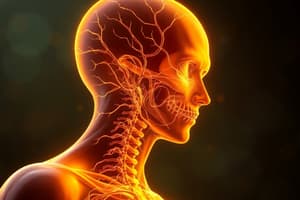Podcast
Questions and Answers
How many pairs of cranial nerves are there?
How many pairs of cranial nerves are there?
- 12 pairs (correct)
- 14 pairs
- 10 pairs
- 11 pairs
Which cranial nerve is noted for arising from both the brain and spinal cord?
Which cranial nerve is noted for arising from both the brain and spinal cord?
- 12th cranial nerve
- 10th cranial nerve
- 9th cranial nerve
- 11th cranial nerve (correct)
What is the total number of spinal nerve pairs in humans?
What is the total number of spinal nerve pairs in humans?
- 28 pairs
- 30 pairs
- 24 pairs
- 31 pairs (correct)
Through what structure do all spinal nerves exit the vertebral column?
Through what structure do all spinal nerves exit the vertebral column?
From where do all cranial nerves exit the cranial cavity?
From where do all cranial nerves exit the cranial cavity?
What is the characteristic of the preganglionic neuron in the autonomic nervous system?
What is the characteristic of the preganglionic neuron in the autonomic nervous system?
Which neurotransmitter is predominantly associated with postganglionic neurons in the autonomic nervous system?
Which neurotransmitter is predominantly associated with postganglionic neurons in the autonomic nervous system?
In what way does the autonomic nervous system differ from the somatic nervous system regarding control?
In what way does the autonomic nervous system differ from the somatic nervous system regarding control?
Where are the cell bodies of postganglionic neurons located in the autonomic nervous system?
Where are the cell bodies of postganglionic neurons located in the autonomic nervous system?
Which of the following functions is primarily controlled by the autonomic nervous system?
Which of the following functions is primarily controlled by the autonomic nervous system?
What type of muscle is primarily affected by the autonomic nervous system?
What type of muscle is primarily affected by the autonomic nervous system?
What characteristic differentiates somatic nervous system neurons from autonomic nervous system neurons?
What characteristic differentiates somatic nervous system neurons from autonomic nervous system neurons?
What type of control is associated with the somatic nervous system?
What type of control is associated with the somatic nervous system?
What is the primary function of the Autonomic Nervous System?
What is the primary function of the Autonomic Nervous System?
Which division of the Peripheral Nervous System is associated with voluntary control?
Which division of the Peripheral Nervous System is associated with voluntary control?
Which of the following correctly categorizes the Sympathetic Nervous System?
Which of the following correctly categorizes the Sympathetic Nervous System?
What differentiates the Somatic Nervous System from the Autonomic Nervous System?
What differentiates the Somatic Nervous System from the Autonomic Nervous System?
How many nerve cells are typically involved in an autonomic nerve pathway?
How many nerve cells are typically involved in an autonomic nerve pathway?
Which component of the Peripheral Nervous System is responsible for involuntary actions?
Which component of the Peripheral Nervous System is responsible for involuntary actions?
What effects does the Parasympathetic Nervous System primarily promote?
What effects does the Parasympathetic Nervous System primarily promote?
What role does the Central Nervous System play in relation to the Peripheral Nervous System?
What role does the Central Nervous System play in relation to the Peripheral Nervous System?
What type of response does the sympathetic nervous system trigger?
What type of response does the sympathetic nervous system trigger?
Which of the following best describes the role of the parasympathetic nervous system?
Which of the following best describes the role of the parasympathetic nervous system?
Where are the cell bodies of preganglionic neurons in the sympathetic nervous system located?
Where are the cell bodies of preganglionic neurons in the sympathetic nervous system located?
What is the primary function of the autonomic nervous system's sympathetic division?
What is the primary function of the autonomic nervous system's sympathetic division?
How do the sympathetic and parasympathetic nervous systems work together?
How do the sympathetic and parasympathetic nervous systems work together?
What characterizes postganglionic fibers in the sympathetic nervous system?
What characterizes postganglionic fibers in the sympathetic nervous system?
Which term is also used to refer to the sympathetic nervous system due to its origin?
Which term is also used to refer to the sympathetic nervous system due to its origin?
What type of activities does the parasympathetic nervous system promote?
What type of activities does the parasympathetic nervous system promote?
What happens to preganglionic sympathetic fibers that do not synapse in prevertebral ganglia?
What happens to preganglionic sympathetic fibers that do not synapse in prevertebral ganglia?
Which course do preganglionic fibers typically take when they remain at the same level?
Which course do preganglionic fibers typically take when they remain at the same level?
What is the function of postganglionic axons in the sympathetic nervous system?
What is the function of postganglionic axons in the sympathetic nervous system?
What neurotransmitters are released by the adrenal medulla in response to sympathetic stimulation?
What neurotransmitters are released by the adrenal medulla in response to sympathetic stimulation?
Which of the following accurately describes the function of splanchnic nerves?
Which of the following accurately describes the function of splanchnic nerves?
How do preganglionic fibers to the adrenal gland differ from other sympathetic fibers?
How do preganglionic fibers to the adrenal gland differ from other sympathetic fibers?
What type of response is associated with the release of neurotransmitters from the adrenal medulla during emergencies?
What type of response is associated with the release of neurotransmitters from the adrenal medulla during emergencies?
Which pathway is NOT followed by preganglionic sympathetic fibers?
Which pathway is NOT followed by preganglionic sympathetic fibers?
Flashcards are hidden until you start studying
Study Notes
Cranial Nerves
- There are 12 pairs of cranial nerves.
- All 12 pairs arise from the brain except the 11th cranial nerve, which originates from the brain and spinal cord.
- All cranial nerves exit the skull through foramina.
Spinal Nerves
- There are 31 pairs of spinal nerves.
- The nerves are grouped as follows: 8 cervical, 12 thoracic, 5 lumbar, 5 sacral, and 1 coccygeal.
- Spinal nerves exit the vertebral column through intervertebral foramina.
Peripheral Nervous System
- The peripheral nervous system (PNS) is comprised of all neural structures outside the central nervous system (CNS).
- The PNS is subdivided into the sensory and motor divisions.
- The sensory division carries information from receptors to the CNS.
- The motor division carries information from the CNS to muscles and glands.
- The motor subdivision includes the somatic and autonomic nervous systems.
- Somatic nervous system controls voluntary movement of skeletal muscles.
- Autonomic nervous system controls the involuntary functions of smooth muscles, cardiac muscles, and glands.
Autonomic Nervous System
- The autonomic nervous system is further divided into the sympathetic and parasympathetic nervous systems.
- The sympathetic nervous system is responsible for the "fight-or-flight" response.
- The parasympathetic nervous system is responsible for the "rest-and-digest" response.
- Both the sympathetic and parasympathetic nervous systems operate in conjunction with each other, maintaining homeostasis in the body.
Sympathetic Nervous System
- The sympathetic nervous system is also called the thoracolumbar system.
- Preganglionic neurons of the sympathetic nervous system originate in the lateral horn of the spinal cord from T1-L2 (L3).
- Sympathetic ganglia are located in two locations: paravertebral ganglia and prevertebral ganglia.
- Paravertebral ganglia form sympathetic trunks located on either side of the vertebral column.
- Prevertebral ganglia surround the origins of main branches of the abdominal aorta.
- Preganglionic fibers are short and myelinated.
- Postganglionic fibers are long and non-myelinated.
Adrenal Gland and Sympathetic Nervous System
- The adrenal gland is an exception to the typical autonomic nervous system pathway.
- Preganglionic sympathetic fibers do not synapse in prevertebral ganglia but directly terminate in cells of the adrenal medulla.
- These cells act as modified postganglionic neurons and release the neurotransmitters epinephrine and norepinephrine directly into the bloodstream, triggering a widespread sympathetic response (adrenaline surge).
Studying That Suits You
Use AI to generate personalized quizzes and flashcards to suit your learning preferences.



